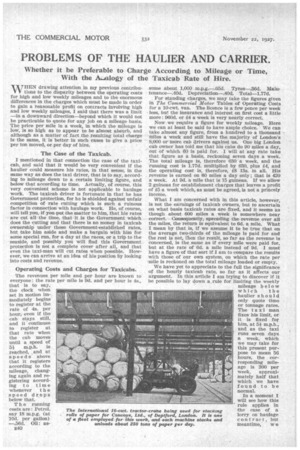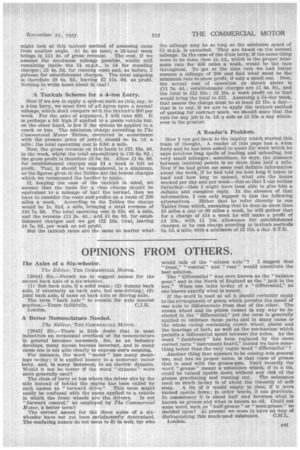PROBLEMS OF THE HAULIER AND CARRIER.
Page 196

Page 197

If you've noticed an error in this article please click here to report it so we can fix it.
Whether it be Preferable to Charge According to Mileage or Time, With the A...alogy of the Taxicab Rate of Hire.
-NAT HEN drawing attention in my previous contributions to the disparity between the operating costs for high and low weekly mileages and to the enormous differences in the charges which must be made in order to gain a reasonable profit on contracts involving high and low weekly mileages, I said that there was a limit —in a downward direction—beyond which it would not be practicable to quote for any job on a mileage basis. The price per mile in a week, in which the mileage is low, is so high as to appear to be almost absurb, and although as a matter of fact the resulting total charge is the same, it is better in such cases to give a price per ton moved, or per day of hire.
The Case of the Taxicab.
I mentioned in that connection the case of the taxicab, and said that it would be very convenient if the haulier could measure his rates, in that sense, in the same way as does the taxi driver, that is to say, according to mileage down to a certain limiting figure, and below that according to time. Actually, of course, this very convenient scheme is not applicable to haulage work. The taxicab driver is fortunate in that he has Government protection, for he is shielded against unfair competition of rate cutting which is such a ruinous factor in connection with haulage work. He, of course, will tell you, if you. put the matter to him, that his rates are cut all the time, that it is the Government which does the cutting and that there is no money in taxicab ownership under those Government-established rates, but take him aside and make a bargain with him for some special run, for a day at the races, or a trip to the seaside, and possibly you will find this Government. protecton is not a complete cover after all, and that even the taxi-man will cut rates when possible. However, we can arrive at an idea of his position by looking into costs and revenue.
Operating Costs and Charges for Taxicabs.
The revenues per mile and per hour are known to everyone: the rate per mile is 9d. and per hour is 4s., that is to say, the clock when set in motion immediately begins to register at the rate of 4s. per hour, even if the cab stays still, and it continues to register at that rate when the cab moves until a speed of 51 m.p.h. is reached, and at speeds above that it registers according to the mileage, changing again and registering according to time whenever the speed drops below that.
The running costs are: Petrol, say 18 m.p.g. (at 100. per gallon) —.560. Oil: as E40 sume about 1,000 m.p.g.—.05d, Tyres-26d. Maintenance—.400. Depreciation—.40d. Total-1.77d.
For standing charges, we may take the figures given in The Commercial Motor Tables of Operating Costs for a 10-cwt. van. The licence is a few pence per week less, but the insurance and interest on first cost a little more: 960d. or £4 a week is very nearly correct.
Now we require a figure for weekly mileage. Here we can at least be said to have ample choice. We can take almost any figure, from a hundred to a thousand miles a week and still have the majority of London's 8,000 or more cab drivers against us. One big London cab owner has told me that his cabs do 90 miles a day, Out of which 60 is paid for. I will at any rate take that figure as a basis, reckoning seven days a week. The total mileage is, therefore 630 a week, and the 'running cost is 1.770. multiplied by 630, plus £4, and the operating cost is, therefore, £8 13s. in all. His _ revenue is earned on 60 miles a day only ; that is 420 a week. At 9d. a mile that is 15 guineas. If we allow 2 guineas for establishment charges that leaves a profit of £5 a week which, as must be agreed, is not a princely income.
What I am concerned with in this article, however, is not the earnings of taxicab owners, but to ascertain on what basis taxicab rates are fixed, and it seems as though about 600 miles a week is somewhere near correct. Consequently, spreading the revenue over all the miles, the return is equivalent to 60. a mile. What I mean by that is, if we assume it to be true that on the average two-thirds of the mileage is paid for and the rest is not, Then the result, so far as the revenue is concerned, is the same as if every mile were paid for, but at the rate of 60. a mile instead of 90. I must have a figure of that sort if I am to compare the results with those of our own system, on which the rate per tmile is reckoned on the total mileage loaded or empty.
We have yet to appreciate to the full the significance of the hourly taxicab rate, so far as it affects our argument. In this article I am trying to discover if it be possible to lay down a,rule for limiting the weekly mileage below which the haulier should only quote time or tonnage rates. The taxi man fixes his limit, or it is fixed for him, at 51 m.p.h., and as the taxi runs seven days a week, which we may take for this present purpose to mean 56 hours, the corresponding mileage is 300 per week, approximately half that which we have found to be normal.
es , owe ye, In a moment I will see how this rule applies in the case of a lorry on haulage contract, but meantime, w e might look at this taxicab method of assessing rates from another angle. At 4s. an hour, a 56-hour week brings in £ll 4i. of gross revenue. The cost, if we assume the maximum mileage possible, whilst still remaining inside the 5i mph., is £4 for standing charges ; £2 4s. 30. for running costs and, as before, 2 guineas for establishment charges. The total outgoing is therefore £8 Os. 3d., leaving £2 17s. 9d. as profit. Nothing to write home about in that! 'A Taxicab Scheme for a 4-ton Lorry. Now if we are to apply a system such as this, say, to a 4-ton lorry, we must first of all agree upon a normal mileage, which shall compare with the taxicab's 600 per week. For the sake of argument, I will take 400. It is perhaps a bit high if applied to a goods vehicle but, on the other hand, is low if the system be applied to a coach or bus. The minimum charge according to The Commercial Motor Tables, corrected in accordance with the present price of petrol, should be is. 1d. a mile: the total operating cost is 9.8d. a mile. Now, the gross revenue on this basis is £21 13s. 1d, in the week, whilst the total expenditure is £16 Os. 841.; the gross profit is therefore £5 6s. 8d. Allow £1 6s. 841. for establishment charges and £4 a week is left as profit. That, it should be remembered, is a minimum, as the figures given in the Tables are the lowest charges which we recommend the haulier to make. If, keeping the case of the taxicab in mind, we assume that the basis for a time charge should be equivalent to a mileage of half the normal, then we have to consider the costs and profits on a basis of 200 miles a week. According to the Tables the charge would be Is. 81d. a mile, bringing a total revenue of £16 7s. 6d. The total operating cost is 13s. 4d. a mile, and the revenue £11 3s. 4d.; add £1 6s. 841. for establishment charges and we get £12 10s. total, leaving £4 7s. 6d. per week as net profit. But the taxicab rates are the same no matter what,• the mileage may be so long as the minimum speed of 5* m.p.h. is exceeded. They are based on the normal mileage. In the case of the 4-ton lorry, if the same thing were to be done, then 1s. id., which is the proper minimum rate for 400 miles a week, would be the rate throughout. To get at the time rate we had better assume a mileage of 200 and find what must be the minimum rate to show profit, if only a small one. Now, the actual cost of operation as shown above is £11 3s. 441.; establishment charges are £1 Os. 8d., and the total is £12 10s.; £2 10s. a week profit on to that would bring the total to £15. Assuming a 5-i-day week, that means the charge must be at least 12 15s. a daythat is to say, if we are to apply the taxicab method of quoting for contract work, we should state that the rate for any job is is. id. a mile or £2 15s, a day whichever is the greater. A Reader's Problem. Now I can get back to the inquiry which started this train of thought. A reader of this page has a 4-ton lorry and he has been asked to quote for work which he says involves long spells of loading and unloading, but very small mileages ; sometimes, he says, the distance between terminal points is no more than half a mile. Now if he had given me some real definite information about the work, if he had told me how long it takes to load and how long to unload, what are the hours worked per day and per week-this so that J can reckon Saturday-then I might have been able to give him a definite and complete reply. In the absence of that information, I can only suggest to him the following alternatives. Either that he refer directly to our Tables from which, assuming that he does no more than 10 miles a day or 60 miles a week, he will gather that for a charge of £14 a week he will make a profit of £4 10s., with 11 10s. allowance for establishment charges, or he can charge acording to taxicab methods 1s. 1d. a mile, with a minimum of £2 15s. a day. S.T.R.Tags


















































































































































































































































































































